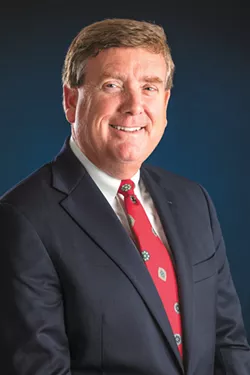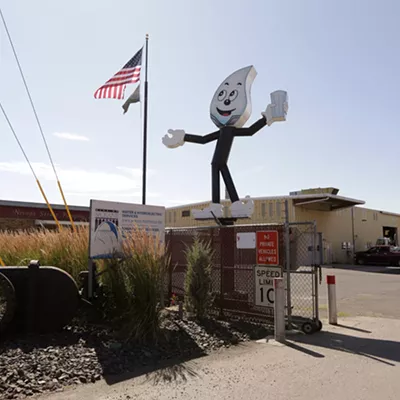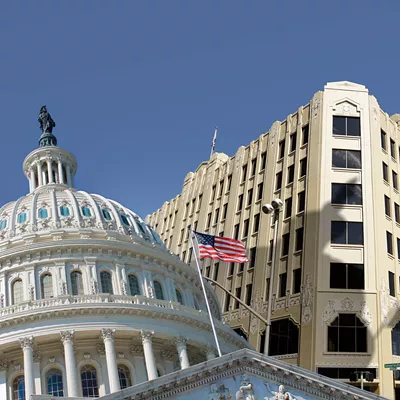
Spokane Mayor Nadine Woodward's first city administrator, hired away from the tiny Central Washington town of Ephrata, resigned after less than a year.
But Woodward says the scale of experience of her new city administrator, Johnnie Perkins, is on an entirely different level. Perkins has been a school board candidate, a trash company lobbyist and, just last year, a deputy chief operating officer for the city of San Diego.
In a city of 1.5 million — nearly seven times Spokane's population and 188 times Ephrata's — Perkins oversaw infrastructure, public works and utilities.
Woodward says that Perkins' references were "absolutely incredible" across the board, with two decades' worth of colleagues from the public and private sectors raving about his record of collaboration and problem-solving.
"One former council member who I spoke to called him Johnnie-On-The-Spot," Woodward says. "He was always there to deal with the issue, to help with the problem, to respond."
But big-city experience can come with big-city baggage. For the past two years, San Diego journalists have been uncovering one damning story after another about the city's involvement with a 19-story building at 101 Ash St. in San Diego's downtown.
At the end of 2019, 800 city employees had been moved into the building despite a flurry of warning signs about its safety. After barely a month, asbestos caused city staffers to flee the facility and the building to be declared a public nuisance.
Today, the building sits empty, the city has refused to continue paying its lease, and the debacle has resulted in a wellspring of lawsuits: from whistleblowers claiming retaliation, from contractors citing endangerment, from journalists demanding public records, from a taxpayer who blames the city for signing the building's lease and from the landlord who blames the city for violating it.
Just last month, the San Diego Union-Tribune's editorial board called for either the state Attorney General's Office or a "respected, independent law firm" to investigate and "get to the bottom of this still-growing scandal."
And during the project's most pivotal months in 2019 and 2020, one of San Diego's highest-ranking officials overseeing it was Johnnie Perkins. It's earned him critics as passionate as his supporters.
"When you get up to that level, and you're making that kind of money, you have a responsibility to blow the whistle to say something," says Arturo Castañares, publisher of the bilingual La Prensa San Diego local newspaper. "You put people's lives at risk."
THE FIXER
Perkins had long been a player in local Republican politics in San Diego, but Woodward says the praise for him is bipartisan."He got along with people on all sides of the political spectrum," Woodward says.
Indeed, while some of the most fiery condemnation of the Ash Street debacle has come from Castañares, the former chairman of the San Diego County Democratic Party, he had positive things to say about Perkins' reputation.
"He was always known as a straight-up guy, a straight shooter," says Castañares. "He's a hands-on guy. And he's a fixer."
When Perkins became one of the city's deputy chief operating officers in August 2018, one of his first missions was to repair San Diego's water department, beset by soaring billing errors and employees who lied on timecards.
"This is part of the culture that we are in the process of changing," Perkins told local reporters.
But Castañares thinks that since then Perkins either succumbed to pressure from the top or "got used to the water temperature" — that he was changed by the city of San Diego's culture of cover-up and obstruction.
Perkins, to be clear, had nothing to do with San Diego's controversial 2016 decision to lease to purchase the deteriorating building. By the time he arrived on the scene, the project had already been cursed by delays related to the discovery of fireproofing material containing asbestos.
Speaking with the Inlander on Monday, Perkins was vague about his role in the project, saying only that he was working with the project team on "various elements of the tenant improvements" task.
Hundreds of San Diego public records reviewed by the Inlander, however, speak to Perkins' hands-on involvement with the Ash Street renovations. As setbacks threatened the project, Perkins was the one demanding the contractors deliver a new budget, timetables and asbestos-containment strategies.
Sometimes he intervened. After a fire protection subcontractor disturbed asbestos with their renovation work, he requested to speak with that company's president personally. When he learned a worker hadn't been wearing protective equipment in the building, he moved to ban that worker from the premises immediately.
"Johnnie was brought in to fix it. The problem is they didn't fix it," Castañares says of Perkins. "And when they knew it was unfixable, that's when they stopped doing the right thing and started doing the wrong thing."
HOLDING THEIR BREATH
On Dec. 16, 2019, San Diego appeared ready to unfurl its "Mission Accomplished" banner. As the city began moving hundreds of employees onto the floors of the Ash Street building, Perkins told the San Diego Union-Tribune that the city was "on time and within budget" and that the $30 million worth of renovations since 2018 would ultimately "save tens of millions of taxpayer dollars over time."But while Perkins and other city leaders celebrated the positive news coverage, they knew that important aspects of the renovation still hadn't been completed.
It didn't take long for the newly moved-in San Diego employees to realize something was wrong. Two days after Christmas, employees were emailing their union to complain about freezing temperatures inside the building, recounting how they were "wearing many layers of clothing, our jackets, beanies, gloves and blankets to try to keep warm."
By early January 2020, the employees read the Union-Tribune to learn that the asbestos violations in their building had continued. San Diego County's air pollution regulator found asbestos-laden material in the building three days before employees started to move in and three days after.
The final blow came on Jan. 14, 2020: San Diego County officials found asbestos in a conference room near city employees. The county declared the site a public nuisance, and on Jan. 17, the city ordered employees to abandon the building.
"By smokey, that was a real game changer," Perkins told the San Diego City Council later that month. "And for me personally, one that cut right to my heart, given where safety is and has been throughout my career."
Cathleen Higgins, labor relations officer with the San Diego Municipal Employees Association, told the council that employees were calling her and were outraged.
"I'm not going to sugarcoat it today," she says. "They're angry. They're scared. They don't believe their city anymore."
But Perkins also laid out a kind of defense before the council. He read a Dec. 11, 2019, letter from David Davey, president of the general contractor on the project, concluding that after an expensive third-party test for airborne asbestos fibers, the city had ensured that "101 Ash Street is safe for City employees and the public to occupy."
But just a few hours before that, Davey had sent a different email to Perkins — one he'd started composing at 2:30 am — hammering home how difficult fixing "the very significant deficiencies of the existing infrastructure" would be in a matter of weeks.
Records show that Davey and other contractors had repeatedly sounded alarms about the deteriorating 60-year-old building's obsolete electric, ventilation, heating and fire suppression systems, only to get pushback from the city officials.
"How are you going to move people into a building without heat? How are you going to move people in there without a proper working fire system?" HVAC subcontractor Scott Lee recalls asking San Diego officials. "I got told point-blank, they didn't have the money, they were going to move forward, they would address it over the next four or five years."
In a high rise, the building's automation system is supposed to slam shut vents, close fire barriers and redirect airflow to deprive the fire of oxygen and prevent fire or smoke from spreading.
But in the Ash Street building, Lee discovered the system was so obsolete as to be inoperable. Worse, Lee says he watched other city contractors bolt open the vents that were supposed to close during a fire after the move-in.
"That was insane," Lee says. Ventilation matters. When a fire broke out in Las Vegas's MGM Grand Casino in 1980, a faulty ventilation system allowed smoke to spread rapidly, injuring 650 and killing 85.
"If there had been a fire and people had died, people would go to prison," says San Diego personal injury attorney Lawrence Shea, who is representing Lee and dozens of others suing the city over the Ash Street project. "It isn't, 'I made a mistake.' It's gross criminal negligence."
Fire doors were missing. The fire alarms had been tested, but weren't connected to the building's automation system.
Normally, fire marshals would flag these problems during a fire inspection. But when employees were moved into the building, it hadn't been fully inspected in more than 2½ years.
According to a report released last year by Hugo Parker, a law firm advising the city of San Diego, city fire marshal Douglas Perry said Perkins was adamant that the fire marshal not be required to test the building's fire systems.
While Perkins had stressed that the building shouldn't be occupied unless it passed its fire safety tests, the fire marshal said, there was tremendous pressure from the "highest levels, if not the highest" to get people moved in.
But asked by the Inlander why he had insisted that the fire marshal not test the building's fire systems, Perkins would only say: "Public safety is our top priority, first, second, and always."
On nearly a dozen occasions during his brief interview with the Inlander, Perkins sidestepped questions about the project with variations of that phrase.
Was the building safe? Why wasn't a fire inspection done? How did he respond to all the red flags raised by contractors and whistleblowers? Perkins would only say that "public safety is the city's top priority."
But Ash Street's problems have grown.
While the Hugo Parker report concluded "at no time was there any true health risk" to workers from asbestos, Shea, the personal-injury lawyer, argues that the tests were seriously flawed.
Lee remembers crawling through a shaft covered in potentially asbestos-laden material. He says he got a CT scan recently, and the doctors found something new.
"I had a mass in my lung," Lee says. "I was sitting there going, 'Is that from this building?'"
Far from being completed on time and on budget, a city-commissioned study last year concluded that to safely occupy the building it would need as much as $115 million in additional repairs and asbestos work, including a nearly total replacement of the ventilation systems.
Three of the officials involved in the Ash Street debacle have resigned. After a new San Diego mayor took office at the end of last year, a city reorganization and budget cuts resulted in a pay cut for Perkins and demotion to environmental services director. But the new mayor has praised Perkins publicly. He tweeted this week that Perkins was "instrumental in multiple major civic projects and initiatives" and declared April 2 "Johnnie Perkins Jr. Day"
Woodward is aware of the Ash Street controversy but expressed confidence in her decision to hire Perkins.
"Johnnie was very transparent with us," Woodward says. "I thought the city did what it believed was the right thing to do."
Asked by the Inlander if he would have done anything differently with the project, he would only say that every project has unique challenges.
"Let's talk about Spokane," Perkins says. "Let's talk about the great community that Spokane is."
He's ready to move on, literally. He ends the interview with movers at his door in San Diego.
"I will lead as I always have: with integrity, transparency, honesty, character and working as a team," Perkins says. "That's how I'm going to address issues in Spokane." ♦




























